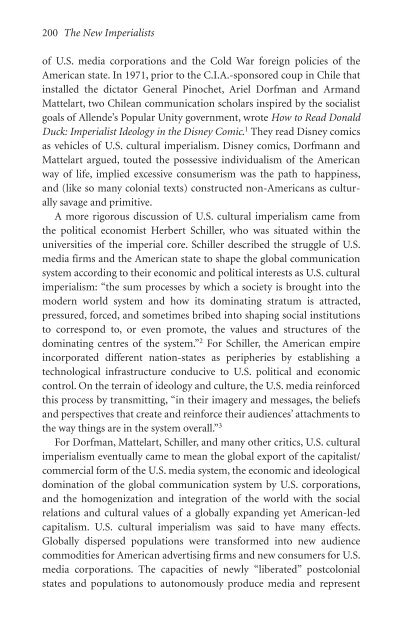New Imperialists : Ideologies of Empire
New Imperialists : Ideologies of Empire
New Imperialists : Ideologies of Empire
You also want an ePaper? Increase the reach of your titles
YUMPU automatically turns print PDFs into web optimized ePapers that Google loves.
200 The <strong>New</strong> <strong>Imperialists</strong><br />
<strong>of</strong> U.S. media corporations and the Cold War foreign policies <strong>of</strong> the<br />
American state. In 1971, prior to the C.I.A.-sponsored coup in Chile that<br />
installed the dictator General Pinochet, Ariel Dorfman and Armand<br />
Mattelart, two Chilean communication scholars inspired by the socialist<br />
goals <strong>of</strong> Allende’s Popular Unity government, wrote How to Read Donald<br />
Duck: Imperialist Ideology in the Disney Comic. 1 They read Disney comics<br />
as vehicles <strong>of</strong> U.S. cultural imperialism. Disney comics, Dorfmann and<br />
Mattelart argued, touted the possessive individualism <strong>of</strong> the American<br />
way <strong>of</strong> life, implied excessive consumerism was the path to happiness,<br />
and (like so many colonial texts) constructed non-Americans as culturally<br />
savage and primitive.<br />
A more rigorous discussion <strong>of</strong> U.S. cultural imperialism came from<br />
the political economist Herbert Schiller, who was situated within the<br />
universities <strong>of</strong> the imperial core. Schiller described the struggle <strong>of</strong> U.S.<br />
media firms and the American state to shape the global communication<br />
system according to their economic and political interests as U.S. cultural<br />
imperialism: “the sum processes by which a society is brought into the<br />
modern world system and how its dominating stratum is attracted,<br />
pressured, forced, and sometimes bribed into shaping social institutions<br />
to correspond to, or even promote, the values and structures <strong>of</strong> the<br />
dominating centres <strong>of</strong> the system.” 2 For Schiller, the American empire<br />
incorporated different nation-states as peripheries by establishing a<br />
technological infrastructure conducive to U.S. political and economic<br />
control. On the terrain <strong>of</strong> ideology and culture, the U.S. media reinforced<br />
this process by transmitting, “in their imagery and messages, the beliefs<br />
and perspectives that create and reinforce their audiences’ attachments to<br />
the way things are in the system overall.” 3<br />
For Dorfman, Mattelart, Schiller, and many other critics, U.S. cultural<br />
imperialism eventually came to mean the global export <strong>of</strong> the capitalist/<br />
commercial form <strong>of</strong> the U.S. media system, the economic and ideological<br />
domination <strong>of</strong> the global communication system by U.S. corporations,<br />
and the homogenization and integration <strong>of</strong> the world with the social<br />
relations and cultural values <strong>of</strong> a globally expanding yet American-led<br />
capitalism. U.S. cultural imperialism was said to have many effects.<br />
Globally dispersed populations were transformed into new audience<br />
commodities for American advertising firms and new consumers for U.S.<br />
media corporations. The capacities <strong>of</strong> newly “liberated” postcolonial<br />
states and populations to autonomously produce media and represent


